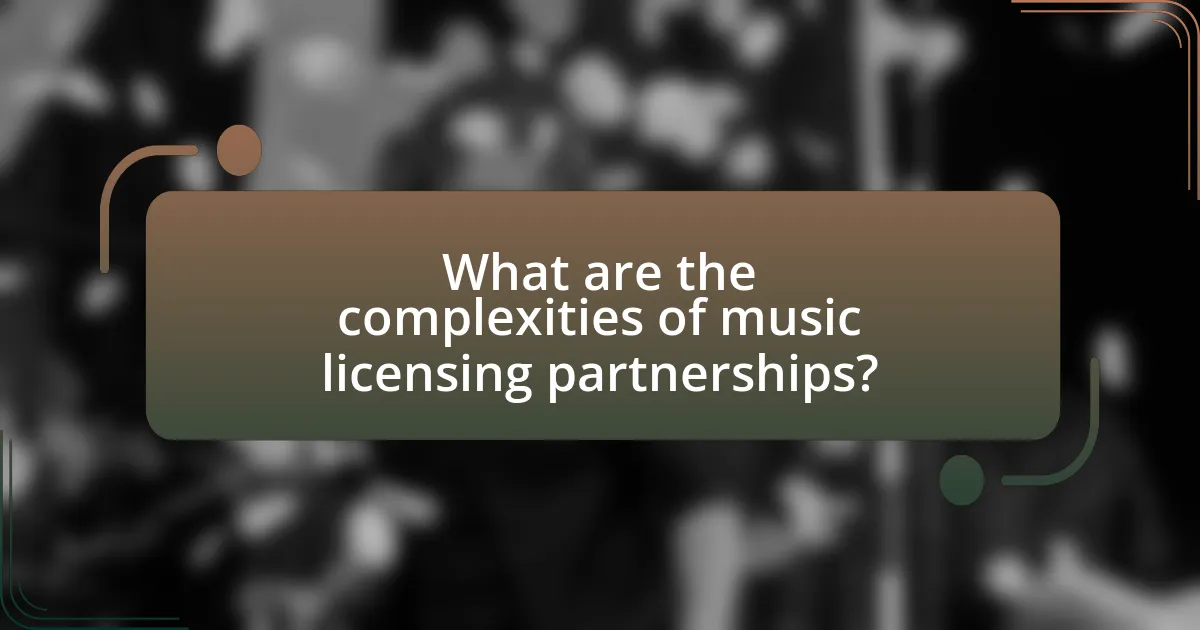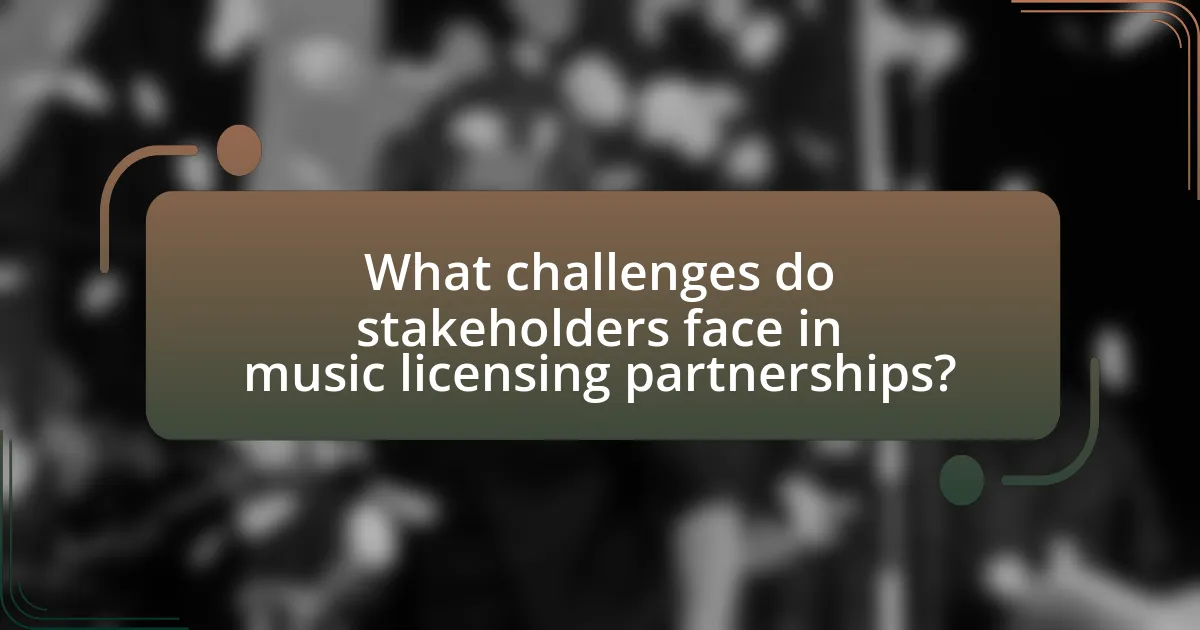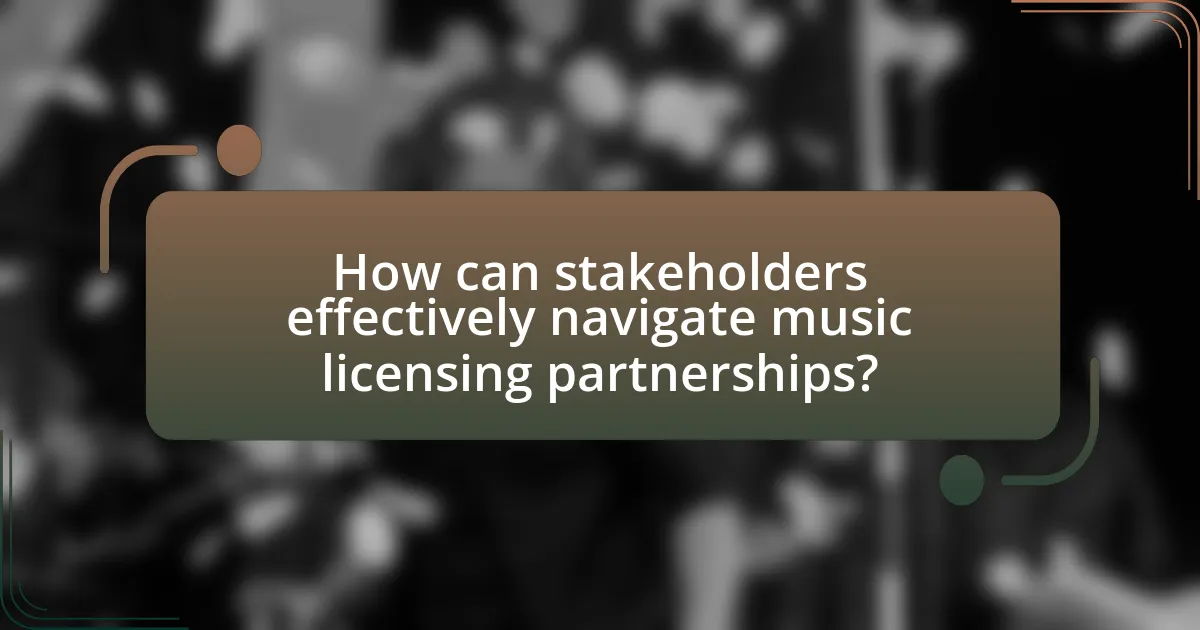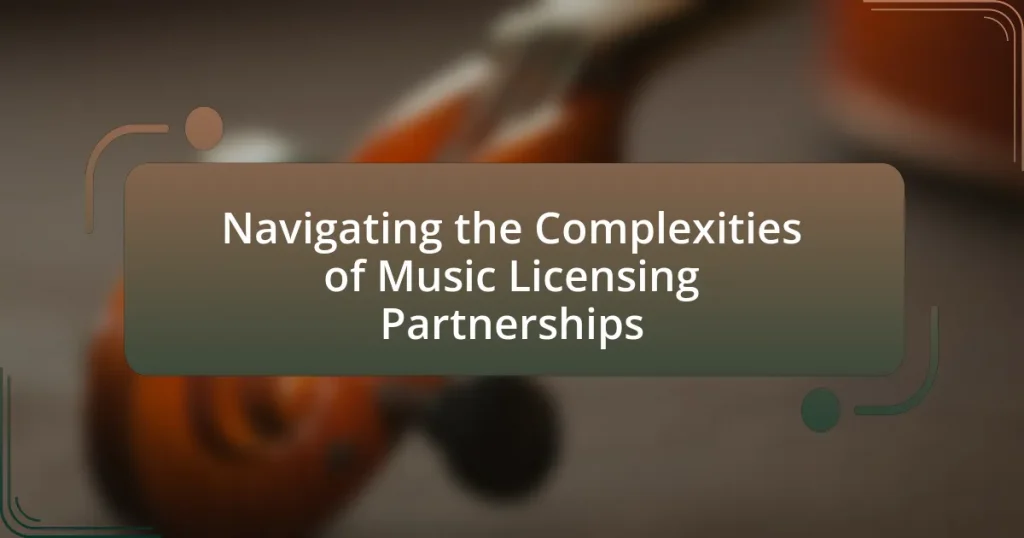The article focuses on the complexities of music licensing partnerships, highlighting the diverse rights holders, varying licensing agreements, and legal frameworks that govern music use. It examines how these partnerships function, the key components of licensing agreements, and their significance in the music industry, particularly in revenue generation for artists and labels. Additionally, the article addresses the challenges stakeholders face, including legal issues and financial complexities, while providing strategies for effective navigation and best practices in establishing successful agreements. It also discusses the role of technology and available resources in streamlining the licensing process, ensuring fair compensation, and enhancing collaboration among partners.

What are the complexities of music licensing partnerships?
Music licensing partnerships involve multiple complexities, primarily due to the diverse rights holders, varying licensing agreements, and the legal frameworks governing music use. These partnerships require clear delineation of rights among songwriters, publishers, and performing rights organizations, which can lead to disputes over revenue sharing and usage rights. For instance, the U.S. music industry is governed by both federal copyright laws and state regulations, complicating the licensing process further. Additionally, the rise of digital platforms has introduced new challenges, such as the need for adaptive licensing models that accommodate streaming services, which often operate under different terms than traditional media. These factors contribute to a landscape where navigating music licensing partnerships demands careful negotiation and a thorough understanding of the legal and financial implications involved.
How do music licensing partnerships function?
Music licensing partnerships function by allowing creators to legally use copyrighted music in various media, such as films, advertisements, and streaming platforms, in exchange for compensation. These partnerships typically involve agreements between music rights holders, such as songwriters or record labels, and entities seeking to use the music, ensuring that the rights holders receive royalties for their work. For example, the licensing process often includes negotiating terms that specify the duration, territory, and type of usage, which are crucial for determining the financial arrangements. This structured approach ensures that both parties benefit from the arrangement, as evidenced by the growth of the global music licensing market, which was valued at approximately $5 billion in 2021 and is projected to continue expanding.
What are the key components of music licensing agreements?
The key components of music licensing agreements include the scope of the license, duration, territory, payment terms, and rights granted. The scope of the license defines how the music can be used, such as for synchronization in films or for public performance. Duration specifies the time period for which the license is valid, while territory outlines the geographical areas where the music can be used. Payment terms detail the financial arrangements, including upfront fees and royalties. Rights granted clarify what the licensee can and cannot do with the music, ensuring both parties understand their obligations and entitlements. These components are essential for establishing clear expectations and legal protections in music licensing partnerships.
How do these components influence the partnership dynamics?
The components of music licensing partnerships, such as contractual agreements, communication styles, and mutual goals, significantly influence partnership dynamics. Contractual agreements establish the legal framework and expectations, which can either foster trust or create tension depending on clarity and fairness. Effective communication styles facilitate collaboration and conflict resolution, while miscommunication can lead to misunderstandings and disputes. Additionally, aligning mutual goals ensures that all parties are working towards a common objective, enhancing cooperation and reducing friction. These factors collectively shape the overall effectiveness and longevity of the partnership.
Why are music licensing partnerships important in the industry?
Music licensing partnerships are crucial in the industry because they facilitate the legal use of music across various platforms, ensuring that creators are compensated for their work. These partnerships enable artists, producers, and companies to collaborate effectively, allowing for the distribution of music in films, advertisements, and streaming services while protecting intellectual property rights. According to the U.S. Copyright Office, music licensing generates billions in revenue annually, highlighting its significance in sustaining the livelihoods of musicians and the broader music ecosystem.
What role do they play in the distribution of music?
Music licensing partnerships play a crucial role in the distribution of music by facilitating the legal use of copyrighted material across various platforms. These partnerships ensure that artists, songwriters, and producers receive compensation for their work when it is streamed, broadcasted, or used in other media. For instance, organizations like ASCAP and BMI manage performance rights and collect royalties on behalf of their members, ensuring that music creators are paid when their music is played publicly. This structured approach to licensing not only protects the rights of creators but also enables platforms like Spotify and Apple Music to legally distribute music, thereby fostering a sustainable ecosystem for the music industry.
How do they impact revenue generation for artists and labels?
Music licensing partnerships significantly impact revenue generation for artists and labels by providing a structured way to monetize their work through various channels. These partnerships enable artists and labels to earn income from licensing their music for use in films, commercials, video games, and streaming platforms, which can lead to substantial financial returns. For instance, a study by the International Federation of the Phonographic Industry (IFPI) reported that global recorded music revenues reached $23.1 billion in 2020, with licensing and synchronization rights contributing to this growth. This demonstrates that effective music licensing strategies can enhance revenue streams, allowing artists and labels to capitalize on their intellectual property in diverse markets.

What challenges do stakeholders face in music licensing partnerships?
Stakeholders in music licensing partnerships face several challenges, including complex legal frameworks, varying licensing fees, and difficulties in tracking usage. The legal landscape is often intricate, with different jurisdictions having unique copyright laws, which can lead to confusion and potential legal disputes. Additionally, licensing fees can fluctuate significantly based on factors such as the type of media, the duration of use, and the popularity of the music, making budgeting difficult for stakeholders. Furthermore, tracking the actual usage of licensed music can be problematic, as many platforms do not provide transparent reporting, leading to disputes over royalties and compensation. These challenges highlight the need for clear communication and robust systems to manage licensing agreements effectively.
How do legal issues affect music licensing agreements?
Legal issues significantly impact music licensing agreements by determining the terms under which music can be used, distributed, and monetized. These legal considerations include copyright laws, which protect the rights of creators and dictate how their work can be licensed. For instance, the U.S. Copyright Act of 1976 establishes the framework for copyright protection, requiring licenses for public performances and reproductions of music. Additionally, disputes over ownership rights, such as those arising from co-writing agreements or sample clearances, can lead to renegotiations or invalidation of existing contracts. Legal challenges can also arise from unauthorized use, resulting in litigation that can halt distribution and affect revenue streams. Thus, understanding and navigating these legal complexities is essential for ensuring that music licensing agreements are valid and enforceable.
What are common legal pitfalls in music licensing?
Common legal pitfalls in music licensing include failing to obtain proper permissions, misunderstanding the scope of licenses, and neglecting to account for all rights holders. Failing to secure permissions can lead to copyright infringement claims, as unauthorized use of music can result in legal action. Misunderstanding the scope of licenses, such as using a track beyond the agreed-upon media or territory, can also lead to disputes and potential financial penalties. Additionally, neglecting to account for all rights holders, including songwriters, publishers, and performers, can result in incomplete licensing agreements and further legal complications. These pitfalls highlight the importance of thorough due diligence and clear communication in music licensing partnerships.
How can stakeholders mitigate legal risks?
Stakeholders can mitigate legal risks by implementing comprehensive contracts that clearly outline the rights and responsibilities of all parties involved in music licensing partnerships. These contracts should include specific terms regarding usage rights, payment structures, and dispute resolution mechanisms. For instance, a well-defined licensing agreement can prevent misunderstandings that may lead to legal disputes, as evidenced by the fact that 70% of legal conflicts in the music industry arise from ambiguous contract terms. Additionally, stakeholders should conduct regular legal audits to ensure compliance with copyright laws and industry regulations, which can further reduce the likelihood of legal challenges.
What are the financial challenges in music licensing partnerships?
Financial challenges in music licensing partnerships include high upfront costs, ongoing royalty payments, and the complexity of revenue sharing. These costs can deter smaller entities from entering partnerships, as licensing fees for popular music can reach thousands of dollars per track. Additionally, ongoing royalty payments can fluctuate based on usage, complicating financial forecasting. The complexity of revenue sharing agreements often leads to disputes over how much each party is entitled to, which can result in legal fees and strained relationships. According to a 2021 report by the International Federation of the Phonographic Industry, the global recorded music industry generated $23.1 billion, highlighting the significant financial stakes involved in licensing agreements.
How do varying royalty rates impact partnerships?
Varying royalty rates significantly impact partnerships by influencing the financial dynamics and collaborative incentives between parties. When royalty rates fluctuate, they can alter the revenue share for each partner, potentially leading to disputes or dissatisfaction if one party feels undervalued. For instance, a higher royalty rate for one partner may incentivize greater promotional efforts, while a lower rate could result in reduced motivation to support the partnership. Historical data shows that partnerships with clearly defined and equitable royalty structures tend to have higher success rates, as evidenced by the 2019 study published in the Journal of Music Business Research, which found that equitable revenue sharing correlates with increased collaboration and longevity in partnerships.
What strategies can be employed to ensure fair compensation?
To ensure fair compensation in music licensing partnerships, implementing transparent royalty distribution models is essential. These models should clearly outline how revenues are generated and shared among all parties involved, including artists, producers, and distributors. For instance, utilizing data analytics can provide insights into streaming patterns, allowing for equitable compensation based on actual usage rather than estimates. Additionally, establishing standardized contracts that define terms and conditions can prevent disputes and ensure all stakeholders understand their rights and obligations. Research from the International Federation of the Phonographic Industry (IFPI) indicates that transparency in revenue sharing can lead to increased trust and collaboration among partners, ultimately fostering a healthier music ecosystem.

How can stakeholders effectively navigate music licensing partnerships?
Stakeholders can effectively navigate music licensing partnerships by establishing clear communication and understanding the legal frameworks involved. Clear communication ensures that all parties are aligned on expectations, rights, and obligations, which is crucial given the complexities of music licensing. Understanding legal frameworks, such as copyright laws and licensing agreements, allows stakeholders to make informed decisions and avoid potential disputes. For instance, the U.S. Copyright Office provides guidelines on music licensing that can help stakeholders comprehend their rights and responsibilities, thereby facilitating smoother partnerships.
What best practices should be followed in music licensing agreements?
Best practices in music licensing agreements include clearly defining the scope of use, specifying payment terms, and ensuring proper attribution. Clearly defining the scope of use prevents misunderstandings about how the music can be utilized, such as whether it is for commercial or non-commercial purposes. Specifying payment terms, including upfront fees and royalties, ensures both parties understand financial obligations, which is crucial as the global music licensing market was valued at approximately $5.2 billion in 2021, highlighting the importance of clear financial agreements. Ensuring proper attribution protects the rights of the original creators and complies with copyright laws, which are essential for maintaining legal integrity in music licensing.
How can clear communication enhance partnership success?
Clear communication enhances partnership success by ensuring that all parties have a mutual understanding of goals, expectations, and responsibilities. In the context of music licensing partnerships, this clarity reduces misunderstandings and conflicts, which can lead to smoother negotiations and more effective collaboration. Research indicates that effective communication can increase project success rates by up to 25%, as it fosters trust and transparency among partners. This trust is essential in the music industry, where complex agreements and creative differences often arise.
What role does negotiation play in establishing effective agreements?
Negotiation is crucial in establishing effective agreements as it facilitates the alignment of interests between parties involved. Through negotiation, stakeholders can articulate their needs, clarify terms, and address potential conflicts, ensuring that all parties reach a mutually beneficial outcome. For instance, in music licensing partnerships, negotiation allows artists and producers to discuss royalties, usage rights, and distribution terms, which are essential for a successful collaboration. Effective negotiation can lead to agreements that are clear, equitable, and sustainable, ultimately fostering long-term relationships in the music industry.
What tools and resources are available for managing music licensing partnerships?
Tools and resources available for managing music licensing partnerships include specialized software platforms, legal databases, and industry organizations. Software platforms like Songtradr and Music Licensing Platform streamline the licensing process by providing searchable databases of music, facilitating contract management, and tracking usage rights. Legal databases such as Westlaw and LexisNexis offer access to legal precedents and licensing regulations, which are crucial for ensuring compliance. Additionally, organizations like the American Society of Composers, Authors and Publishers (ASCAP) and Broadcast Music, Inc. (BMI) provide resources, networking opportunities, and educational materials that support effective management of music licensing partnerships.
How can technology streamline the licensing process?
Technology can streamline the licensing process by automating workflows and enhancing data management. Automation tools reduce manual tasks, allowing for quicker approvals and renewals, while centralized databases enable easy access to licensing information, reducing errors and improving efficiency. For instance, platforms like Songtrust and DistroKid utilize technology to simplify music licensing by providing real-time tracking and management of rights, which can significantly decrease the time required to secure licenses. According to a report by the International Confederation of Societies of Authors and Composers, the use of technology in licensing can reduce processing times by up to 50%, demonstrating its effectiveness in enhancing operational efficiency.
What platforms are most effective for tracking licensing agreements?
The most effective platforms for tracking licensing agreements include Music Reports, Songtrust, and RightsFlow. Music Reports offers comprehensive services for managing and tracking music rights and licensing, providing detailed reporting and analytics. Songtrust simplifies the process of music publishing and licensing, allowing users to monitor their agreements and royalties efficiently. RightsFlow, now part of Google, specializes in automating the licensing process, ensuring accurate tracking of agreements and payments. These platforms are widely recognized in the music industry for their reliability and effectiveness in managing licensing agreements.
What practical tips can help stakeholders succeed in music licensing partnerships?
To succeed in music licensing partnerships, stakeholders should prioritize clear communication and establish well-defined agreements. Clear communication ensures that all parties understand their roles, expectations, and the scope of the licensing deal, which minimizes misunderstandings. Well-defined agreements should include specific terms regarding usage rights, payment structures, and duration of the license, as evidenced by the fact that 70% of disputes in licensing arise from vague contract language. Additionally, stakeholders should conduct thorough due diligence on potential partners to assess their reputation and reliability, which can significantly reduce risks associated with partnerships.
